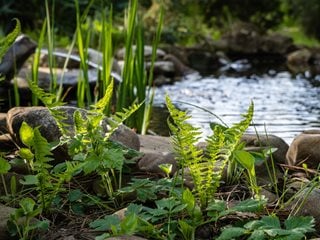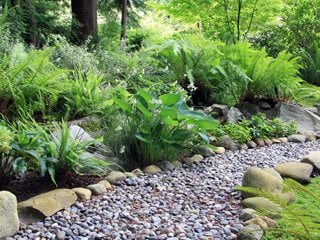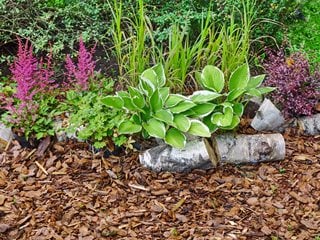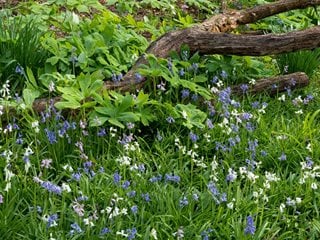How to Design a Woodland Garden
Create a lush woodland sanctuary in your yardBeing outdoors in nature has proven mental and physical health benefits, including better sleep, higher energy, and improved emotional well-being. With the renewed interest in forest bathing, more people are seeking out woodland settings to spend time in.
By taking cues from nature, you can re-create the look of a verdant forest in your own yard. Even a small urban lot can be transformed into a serene shady retreat. A woodland landscape offers privacy and a calming space for peaceful contemplation and relaxing. Here are tips to create a woodland garden in your own yard.
WHAT IS A WOODLAND GARDEN?
A woodland garden mimics a forest as found in nature. It is less formal than other types of landscapes, characterized by trees and larger shrubs that form a canopy, with layered plantings underneath. A woodland garden includes native plants and supports beneficial insects, soil organisms, birds, and other wildlife to form a symbiotic ecosystem.
WOODLAND GARDEN BENEFITS
Some of the many benefits of a woodland garden include:
- Deciduous trees provide shade during hotter months and allow more light during the cold winter season.
- Increased privacy, especially in urban environments
- Taller trees provide a windbreak
- Reduces urban noise
- Less maintenance than a more traditional landscape
- Attracts wildlife
- Creates a calming environment for reading and relaxing, helping to reduce daily stress
PLANNING A WOODLAND GARDEN
Evaluate your site.
Choose an area of your yard for creating a woodland retreat. Evaluate for light, soil, and drainage. Your yard may have existing shade trees, or be a clean slate. Observe how the light falls at different times of year. A woodland garden typically receives dappled shade or partial sun. Deciduous trees will shed their leaves in fall, allowing more light until they leaf back out in spring. Make note of any microclimates that will affect growing conditions.
Research.
Look for ideas on the internet, in books, and by visiting local gardens and nurseries to get ideas. Make a list of plants native to your region, and include a mix of trees, shrubs, perennials, ground covers, and bulbs. Non-natives can be included as well. Choose plants with multi-seasonal attributes and varieties that will provide food, shelter, and nesting sites for wildlife.
Draw up a design.
Make a plan and draw a rough sketch. Include areas for pathways, hardscape and seating, and consider accessories such as containers, water features, and statuary. For bigger projects, consult with a landscape design professional.
WOODLAND GARDEN DESIGN PRINCIPLES
Style.
A woodland landscape is less formal style of garden and includes natural woodland features that complement the surroundings. Choose natural materials for paths, benches, borders, hardscaping, and accessories. Use river rock and boulders rather than pavers or bricks. Allow wooden fences and gates to fade for a weathered look. Include a pond, bubbler, or birdbath rather than a formal style fountain.
Scale.
Keep landscape features in scale with your home and yard. Dwarf plant varieties won’t outgrow smaller yards, while the same plants can get lost on a large country estate. A small bistro set is suited to a small urban lot, while larger patio furniture is more appropriate for a spacious property.
Color.
Natural forest colors of green, brown, and blue elicit an organic, earthy feel. Select a muted color palette for furnishings and accessories that blends with the surroundings. Use bolder colors sparingly.
Placement.
Add pathways to connect the garden to the home, and to different areas of the yard. Incorporate borrowed views of the surrounding terrain. Create intentional min-retreats by placing seating areas at inviting spots such as underneath a shade tree, next to a pond, or near a favorite scented plant.
Keep it simple.
Keep the design simple, especially in smaller spaces. Feature a few key plants and repeat them throughout the yard to unify the landscape. A design that is too busy will detract from the serene ambiance.
Pathways.
Paths should be gentle and meandering rather than straight for a less formal look. Partially obscured views encourage exploration and contemplative strolling. Use natural materials of gravel, wood chips, or shredded bark. Pathways can be outlined with logs or rocks.
Engage the senses.
Include elements that engage the senses. Add fragrant plants, a water feature that provides the soothing sound of trickling water, and provide a hospitable environment to attract songbirds with their cheerful calls. Create serene yet engaging vignettes for visual appeal and add textured elements such as leaves or hardscape that are inviting to touch.
Furniture.
Include rustic benches made from stone or wood, Adirondack chairs, twig furniture, and stumps and logs that can be used as seating and tables. Cedar and redwood are more durable.
Water features.
Natural water features such as ponds, streams, rivers, and lakes are a common component of woodland settings. Water is essential for birds, insects, and other wildlife. Even in a small yard, you can add a tabletop fountain to provide water sounds, or include birdbaths and saucers filled with water.
Attract wildlife.
Provide basic needs of food, water, and shelter to attract small mammals, birds, bees, butterflies, and other beneficial insects. Trees, shrubs, fallen logs, hollows, and bird houses provide shelter and nesting habitat. Include plants that attract wildlife which will produce nectar, seeds, and berries for food. Place a variety of water features around the yard to appeal to different types of wildlife. (See: 10 Ways to Build a Garden for Wildlife for more ideas.)
HOW TO PLANT A WOODLAND GARDEN
Light.
Woodland gardens receive dappled shade or partial sun. If you are planting your site from scratch, start out with plants that are tolerant of more sun until trees and larger shrubs grow tall enough to protect shade-loving plants.
Soil.
A woodland forest floor consists of moist soil enriched from decomposed fallen leaves. Woodland plants perform best in rich, well-draining soil with a slightly acidic pH. Conduct a soil test to determine what your soil pH is and any nutrient deficits. Amend your site with compost and other organic matter and improve drainage as needed.
Siting plants.
Place plants at irregular intervals so the landscape doesn’t appear too symmetrical.
Mulch.
Apply an organic mulch such as pine needles, shredded leaves or bark in newly planted areas. This will help suppress weeds, retain moisture, and add nutrients to the soil.
Water.
Irrigate new plants regularly until established. Mature native plants will need little or no supplemental water after the first year or two. Areas around trees where plants compete for water and nutrients may need extra irrigation, particularly during prolonged hot and dry spells.
Fertilizing.
Woodland landscapes and native plants need little or no supplemental fertilizing. Mature deciduous trees and shrubs may eventually provide enough fallen leaf debris to replenish the soil. If desired, apply compost or other organic matter around plants that will slowly break down and provide nutrients.
SELECTING PLANTS FOR A WOODLAND GARDEN
Plant natives.
Choose native woodland plants endemic to your particular region. Non-natives can also be incorporated. Include shade-tolerant trees, shrubs, perennials, and ground covers.
Choose the right-sized trees.
Select trees and shrubs that will stay in scale with the size of your property and won’t become overgrown. For small urban lots, one or two primary trees may be all you have room for. Smaller trees and dwarf varieties are more suited to compact urban yards, while larger trees will have ample room to grow on spacious country acreage.
Layer plantings.
Include garden layers: canopy, understory, shrub layer, and ground cover plants for a tapestry of color. Include a mix of trees, flowering shrubs, perennials, and bulbs.
Plant for year-round interest.
Choose plants with multi-seasonal interest for year-round appeal. Include varieties with contrasting textures, leaf shapes, flower color, berries, fall color, and attractive bark. Plant spring ephemerals such as trillium, snowdrops, winter aconite, and cyclamen that will go dormant in summer and intersperse ground cover plants such as sweet woodruff, wild strawberry, and ginger that will continue to provide interest through summer and fall. Incorporate broadleaf evergreens and conifers that will keep their foliage year-round.
Planting underneath trees.
Areas under trees can be difficult to plant and maintain. Trees have dense root systems that force other plants to compete for water and nutrients. Choose smaller perennials and bulbs and avoid damaging tree roots when planting. Some of the best plants for underneath trees and other challenging dry shade areas include ajuga, bishop’s hat, cyclamen, lily of the valley, liriope, snowdrops, sweet woodruff, vinca, violet, wild strawberry and windflower. (See: Underplanting Large Trees: 5 Expert Tips)
Include ferns.
Ferns are an integral part of woodland landscapes. Include native ferns and varieties in different sizes, leaf shapes and textures for contrast. (See: 15 Best Ferns to Grow Outdoors for ideas.)
PLANTS FOR WOODLAND GARDENS
| TREES | Birch, cherry, crabapple, dogwood, Japanese maple, maple, oak, redbud, serviceberry, stewartia |
| SHRUBS | Azalea, camellia, hydrangea, mountain laurel, pieris, red twig dogwood, rhododendron, spicebush, viburnum, witch hazel |
| PERENNIALS | Astilbe, bishop’s hat, black cohosh, bleeding heart, bluebell, columbine, coral bells, ferns, foamflower, foxglove, geranium, hellebore, hosta, lungwort, meadow rue, phlox, primrose, Siberian bugloss, Solomon’s seal, spiderwort, winter aconite |
| GROUND COVERS | Ajuga, ginger, lamium, lily of the valley, liriope, trillium, sweet cicely, sweet woodruff, violet, wild strawberry |
| BULBS | Anemone, crocus, cyclamen, daffodil, dwarf iris, erythronium, fritillaria, glory-of-the-snow, muscari, snowdrop |
HOW TO MAINTAIN A WOODLAND GARDEN
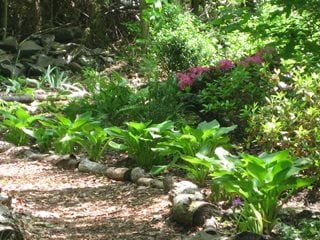
Photo: Kevin Lee Jacobs. (See more of this garden)
A woodland landscape is lower maintenance than many other types of gardens. Allow your yard to retain a naturalistic appearance.
Pruning.
If tree canopies become too dense, they can be thinned out to allow more dappled light. This may require an experienced arborist. For trees and shrubs, cut out dead, diseased or broken branches. Evaluate plants on an individual basis to determine the best time to prune.
Fall cleanup.
Woodland plants are nourished in their native habitat by leaves that fall to the forest floor and decompose into the soil to feed plants. In fall, clean off pathways, patios, and other trafficked areas and rake leaves into garden beds. The leaf litter will decompose, providing nutrients and helping to insulate plants over the winter. Leaves can be shredded with a lawn mower to aid decomposition.
Spring maintenance.
In spring, remove leaves from around the base of plants. Leaves may develop a matted layer that should be aerated or broken up. Garden beds will eventually need little or no supplemental compost or other nutrients, as decayed leaves will continue to feed plants throughout the growing season.
RELATED:
Shade Garden Ideas & Design
8 Expert Tips for Stunning Shade Combinations
Designing With Foliage Over Flowers

